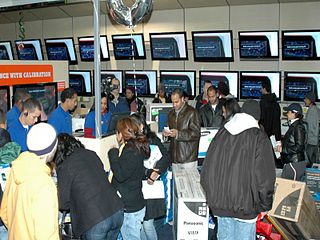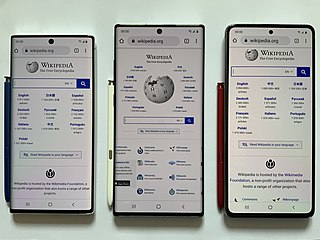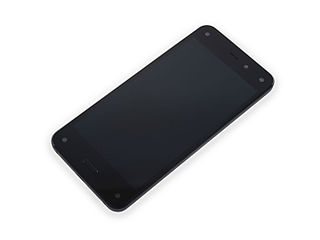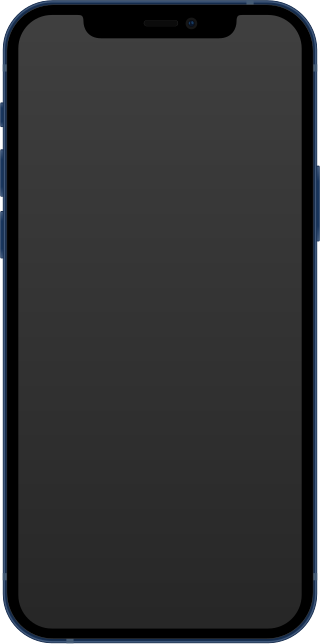
A smartphone is a mobile device that combines the functionality of a traditional mobile phone with advanced computing capabilities. It typically has a touchscreen interface, allowing users to access a wide range of applications and services, such as web browsing, email, and social media, as well as multimedia playback and streaming. Smartphones have built-in cameras, GPS navigation, and support for various communication methods, including voice calls, text messaging, and internet-based messaging apps.

Consumer electronics or home electronics are electronic equipment intended for everyday use, typically in private homes. Consumer electronics include devices used for entertainment, communications and recreation. These products are usually referred to as black goods due to many products being housed in black or dark casings. This term is used to distinguish them from "white goods" which are meant for housekeeping tasks, such as washing machines and refrigerators, although nowadays, these would be considered black goods, some of these being connected to the Internet. In British English, they are often called brown goods by producers and sellers. In the 2010s, this distinction is absent in large big box consumer electronics stores, which sell entertainment, communication and home office devices, light fixtures and appliances, including the bathroom type.
In economics and industrial design, planned obsolescence is the concept of policies planning or designing a product with an artificially limited useful life or a purposely frail design, so that it becomes obsolete after a certain pre-determined period of time upon which it decrementally functions or suddenly ceases to function, or might be perceived as unfashionable. The rationale behind this strategy is to generate long-term sales volume by reducing the time between repeat purchases. It is the deliberate shortening of the lifespan of a product to force people to purchase functional replacements.

A camera phone is a mobile phone which is able to capture photographs and often record video using one or more built-in digital cameras. It can also send the resulting image wirelessly and conveniently. The first commercial phone with color camera was the Kyocera Visual Phone VP-210, released in Japan in May 1999.
iFixit is an American e-commerce and how-to website that sells repair parts and publishes free wiki-like online repair guides for consumer electronics and gadgets. The company also performs product tear-downs of consumer devices. It is a private company in San Luis Obispo, California founded in 2003, spurred by Kyle Wiens not being able to locate an Apple iBook G3 repair manual while the company's founders were attending Cal Poly San Luis Obispo.

Retina display is a branded series of IPS LCDs and OLED displays by Apple Inc. that have a higher pixel density than traditional displays. Apple has registered the term "Retina" as a trademark with regard to computers and mobile devices with the United States Patent and Trademark Office and Canadian Intellectual Property Office. The applications were approved in 2012 and 2014 respectively. The Canadian application cited a 2010 application in Jamaica.

A smartwatch is a portable and wearable computer device in a form of a watch; modern smartwatches provide a local touchscreen interface for daily use, while an associated smartphone app provides management and telemetry, such as long-term biomonitoring. While early models could perform basic tasks such as calculations, digital time telling, translations, and game-playing, smartwatches released since 2015 have more general functionality closer to smartphones, including mobile apps, a mobile operating system, and WiFi/Bluetooth connectivity. Some smartwatches function as portable media players, with FM radio and playback of digital audio and video files via a Bluetooth headset. Some models, called watch phones, have mobile cellular functionality such as making telephone calls.
IEEE 802.11ac-2013 or 802.11ac is a wireless networking standard in the IEEE 802.11 set of protocols, providing high-throughput wireless local area networks (WLANs) on the 5 GHz band. The standard has been retroactively labelled as Wi-Fi 5 by Wi-Fi Alliance.

A phablet is a mobile device combining or straddling the size formats of smartphones and tablets. The word is a portmanteau of phone and tablet. The term is largely obsolete by the late 2010s, since average smartphone sizes eventually morphed into small tablet sizes, up to 6.9 inches (180 mm), with wider aspect ratios.
The Samsung SGH-T669 is a 3G-capable smartphone manufactured by Samsung. In the US it is also called the Samsung Gravity T; in Canada, the Samsung Gravity Touch.

The Fire Phone is a discontinued 3D-enabled smartphone developed by Amazon and manufactured by Foxconn. It was announced on June 18, 2014, and marked Amazon's first foray into the smartphone market, following the success of the Kindle Fire. It was available for pre-order on the day it was announced. In the United States, it launched as an AT&T exclusive on July 25.

A modular smartphone is a smartphone designed for users to upgrade or replace components and modules without the need for resoldering or repair services. The most important component is the main board, to which others such as cameras and batteries are attached. Components can be obtained from open-source hardware stores.

Samsung Electronics Co., Ltd. is a South Korean multinational major appliance and consumer electronics corporation headquartered in Yeongtong-gu, Suwon, South Korea. It is currently the pinnacle of the Samsung chaebol, accounting for 70% of the group's revenue in 2012.

The iPhone 8 and iPhone 8 Plus are smartphones designed, developed, and marketed by Apple Inc. They are the eleventh generation of the iPhone. The iPhone 8 was released on September 22, 2017, succeeding the iPhone 7 and iPhone 7 Plus respectively.
Electronics right to repair is proposed legislation that would provide the practical means for electronics equipment owners to repair their devices. Repair is legal under copyright law and patent law. However, owners and independent technicians are often unable to make their own repairs because of manufacturer limitations on access to repair materials such as parts, tools, diagnostics, documentation and firmware.

The iPhone XS and iPhone XS Max are smartphones designed, developed and marketed by Apple Inc. They are the twelfth-generation flagships of the iPhone, succeeding the iPhone X. Apple CEO Tim Cook announced the devices alongside a lower-end model, the iPhone XR, on September 12, 2018, at the Steve Jobs Theater at Apple Park. Pre-orders began on September 14, 2018, and the devices went on sale on September 21. As of March 2024, the iPhone XS is the oldest iPhone model officially capable of running iOS 17, the current version of iOS.

The iPhone 12 and iPhone 12 Mini are smartphones designed, developed, and marketed by Apple Inc. They are the fourteenth-generation iPhones, succeeding the iPhone 11. They were unveiled at a virtually held Apple Special Event at Apple Park in Cupertino, California, on October 13, 2020, alongside the "premium flagship" iPhone 12 Pro and iPhone 12 Pro Max and HomePod Mini. Pre-orders for the iPhone 12 started on October 16, 2020, and the phone was released in most countries on October 23, 2020, alongside the iPhone 12 Pro and fourth-generation iPad Air. Pre-orders for the iPhone 12 Mini began on November 6, 2020, and the phone was released on November 13, 2020, alongside the iPhone 12 Pro Max.
Right to repair is a legal right for owners of devices and equipment to freely modify and repair products such as automobiles, electronics, and farm equipment. Right to repair may also refer to the social movement of citizens putting pressure on their governments to enact laws protecting a right to repair.

The iPhone 13 and iPhone 13 Mini are smartphones designed, developed, marketed, and sold by Apple Inc. They are the fifteenth generation of iPhones. They were unveiled at an Apple Event in Apple Park in Cupertino, California, on September 14, 2021, alongside the higher-priced iPhone 13 Pro and iPhone 13 Pro Max flagships. Pre-orders for the iPhone 13 and iPhone 13 Mini began on September 17, 2021. They were officially released on September 24, 2021. As of April 2024, the iPhone 13 is the oldest iPhone model still officially sold by, and fully supported by Apple.

The iPhone 14 and iPhone 14 Plus are smartphones designed, developed, and marketed by Apple Inc. They are the sixteenth-generation iPhones, succeeding the iPhone 13 and iPhone 13 Mini, and were announced during Apple Event, Apple Park in Cupertino, California, on September 7, 2022, alongside the higher-priced iPhone 14 Pro and iPhone 14 Pro Max flagships. The iPhone 14 and iPhone 14 Plus feature a 6.1-inch (15 cm) and 6.7-inch (17 cm) display, improvements to the rear-facing camera, and satellite connectivity for contacting emergency services when a user in trouble is beyond the range of Wi-Fi or cellular networks. The iPhone 14 was made available on September 16, 2022, and iPhone 14 Plus was made available on October 7, 2022, priced at $799 and $899 respectively and was launched with iOS 16. Pre-orders for the iPhone 14 and iPhone 14 Plus began on September 9, 2022. Along with the 14 Pro and 14 Pro Max, the iPhone 14 and 14 Plus are the last iPhones to feature the Lightning port, as their successors, the iPhone 15 and 15 Plus, use a USB-C port instead, per European Commission regulation.















